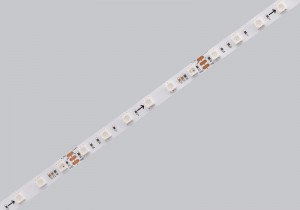Strisce luminose RGB SPI 24V 84LED 10MM
●Colori ed effetti programmabili infiniti (inseguimento, flash, flusso, ecc.).
●Multitensione disponibile: 5V/12V/24V
●Temperatura di lavoro/stoccaggio: Ta: -30~55°C / 0°C~60°C.
●Durata: 35000 ore, 3 anni di garanzia


La resa cromatica è una misura della fedeltà dei colori sotto la sorgente luminosa. Sotto una striscia LED a basso CRI, i colori potrebbero apparire distorti, sbiaditi o indistinguibili. I prodotti LED ad alto CRI offrono una luce che consente agli oggetti di apparire come se fossero sotto una sorgente luminosa ideale, come una lampada alogena o la luce naturale del giorno. È inoltre importante verificare il valore R9 di una sorgente luminosa, che fornisce ulteriori informazioni sulla resa dei colori rossi.
Hai bisogno di aiuto per decidere quale temperatura colore scegliere? Guarda il nostro tutorial qui.
Regola i cursori qui sotto per una dimostrazione visiva del confronto tra CRI e CCT in azione.
Più caldo ←CCT→ Più fresco
Inferiore ←CRI→ Più in alto
#ARCHITETTURA #COMMERCIALE #CASA #ESTERNO #GIARDINO
La striscia LED SPI (Serial Peripheral Interface) è un tipo di striscia LED digitale che utilizza il protocollo di comunicazione SPI per controllare i singoli LED. Offre un maggiore controllo su colore e luminosità rispetto alle tradizionali strisce LED analogiche. Alcuni dei vantaggi delle strisce LED SPI sono i seguenti: 1. Maggiore precisione del colore: le strisce LED SPI offrono un controllo preciso del colore e possono visualizzare un'ampia gamma di colori con precisione. 2. Frequenza di aggiornamento rapida: la frequenza di aggiornamento rapida delle strisce LED SPI riduce lo sfarfallio e migliora la qualità complessiva dell'immagine. 3. Migliore controllo della luminosità: le strisce LED SPI offrono un controllo della luminosità a grana fine, consentendo sottili modifiche ai livelli di luminosità dei singoli LED.
Una striscia di pixel dinamica è un tipo di striscia luminosa a LED in grado di cambiare colore e pattern in risposta a input esterni come sensori sonori o di movimento. Queste strisce utilizzano un microcontrollore o un chip personalizzato per controllare le singole luci nella striscia, consentendo di visualizzare un'ampia gamma di combinazioni di colori e pattern. Il microcontrollore o il chip riceve dati da una sorgente di input, come un sensore sonoro o un programma per computer, e li utilizza per determinare il colore e il pattern di ogni singolo LED. Questi dati vengono quindi inviati alla striscia di LED, che illumina ciascun LED in base ai dati ricevuti. Le installazioni di illuminazione e gli spettacoli teatrali utilizzano spesso strisce di pixel dinamiche.
Le strisce LED DMX utilizzano il protocollo DMX (Digital Multiplex) per controllare i singoli LED, mentre le strisce LED SPI utilizzano il protocollo Serial Peripheral Interface (SPI). Rispetto alle strisce LED analogiche, le strisce DMX offrono un maggiore controllo su colore, luminosità e altri effetti, mentre le strisce SPI sono più facili da usare e più adatte a installazioni di piccole dimensioni. Le strisce SPI sono popolari in progetti hobbistici e fai-da-te, mentre le strisce DMX sono più comuni nelle applicazioni di illuminazione professionale.
| Codice articolo | Larghezza | Voltaggio | Max W/m | Taglio | Lm/M | Colore | CRI | IP | Tipo di circuito integrato | Controllare | L70 |
| MF350A084A00-D000I1A10106S | 10MM | DC24V | 12W | 83,3 MM | / | RGB | N / A | IP65 | FW1935 14MA | SPI | 35000H |


 cinese
cinese














